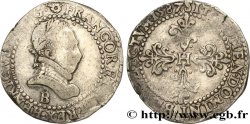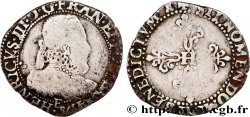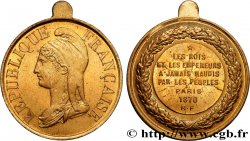Live auction - fme_966095 - HENRY III Médaille, Renouvellement du traité de Soleure, refrappe
Чтобы принять участие в торгах, вы должны войти в систему и стать подтвержденным участником аукциона. Войдите, чтобы сделать ставку. Ваш аккаунт будет подтвержден в течение 48 часов. Не ждите до закрытия торгов, чтобы зарегистрироваться.Сделав ставку на данный товар, вы вступаете в юридическое соглашение на покупку выбранного товара и нажатием кнопки «Сделать ставку» подтверждаете принятие вами условий интернет-аукционов cgb.fr.
Ставка может бить сделана только в полном эквиваленте евро. Торги закроются согласно времени, указанному в описании товара, все ставки, сделанные после закрытия торгов, учитываться не будут. Не следует откладывать предложение вашей ставки до последнего момента, так как система может не успеть обработать вашу заявку, и ваша ставка не будет принята. Более детальную информацию вы найдёте здесь: FAQ по интернет-аукционам.
Все ставки победителей подлежат комиссии 18%.
Все ставки победителей подлежат комиссии 18%.
| Оценить : | 60 € |
| Цена : | 30 € |
| Максимальная предлагаемая цена : | 30 € |
| Конец торгов : | 19 November 2024 14:38:09 |
| Участников : | 1 Участников |
Тип Médaille, Renouvellement du traité de Soleure, refrappe
Дата: (1582)
Металл: bronze
Диаметр: 42 mm
Ориентация осей монеты: 12 h.
Гравер PILON Germain
Вес: 32,02 g.
Век: lisse + corne BRONZE
Пуансон: corne BRONZE
Комментарии о состоянии
Patine marron hétérogène avec des points noires d’oxydation à l’avers. Quelques points d’usure
Лицевая сторона
Аверс: легенда: HENRICVS. III. D. G. FRANCORVM. ET. POL. REX.
Аверс: описание: Buste habillé et drapé de la reine Catherine de profil à gauche.
Обратная сторона
Реверс: легенда: FOEDERE / CVM / HELVETIIS / ET / RAETHIS / RENOVA / TO // MDLXXXII.
Реверс: Описание: Légende en sept lignes dans une couronne d’olivier ; date à l’exergue.
Комментарий
Il y eut trois traités de Soleure, en 1579, 1602 et 1663. Celui de 1579 renouvelle le traité de Fribourg de 1516, qui établissait la paix perpétuelle entre la France et la Suisse. Il est lui-même renouvelé le 25 juillet 1582 ; prétexte de notre médaille.
Germain Pilon, né vers 1528 à Paris et mort en 1590 dans la même ville, est l'un des plus importants sculpteurs de la Renaissance française. Il a été le sculpteur des tombes des rois français du XVIe siècle. Nommé contrôleur des Poinçons et Monnaies du roi, il apprend également l'art de la fonte et du ciselage du bronze. De 1558 à sa mort, il travaille pour la Cour de France, réalisant les monuments funéraires de François Ier et d'Henri II, les gisants de ce dernier et de Catherine de Médicis, ainsi que les monnaies royales, la statuaire de la chasse de Sainte Geneviève. Il est également un sculpteur apprécié de l'aristocratie française, là encore spécialisé dans l'art funéraire. Dans son atelier travaillent ses fils, ainsi que Mathieu Jacquet, lesquels assurent le succès du style de Pilon sur plusieurs décennies.
There were three Treaties of Solothurn, in 1579, 1602, and 1663. The 1579 Treaty renewed the 1516 Treaty of Fribourg, which established perpetual peace between France and Switzerland. It was itself renewed on July 25, 1582; the pretext for our medal. Germain Pilon, born around 1528 in Paris and died in 1590 in the same city, was one of the most important sculptors of the French Renaissance. He sculpted the tombs of 16th-century French kings. Appointed Controller of the King's Hallmarks and Coins, he also learned the art of bronze casting and chiseling. From 1558 until his death, he worked for the Court of France, creating the funerary monuments of Francis I and Henry II, the recumbent statues of the latter and Catherine de Medici, as well as the royal coins, the statuary of the hunt of Saint Genevieve. He was also a sculptor appreciated by the French aristocracy, again specializing in funerary art. His sons, as well as Mathieu Jacquet, worked in his workshop, ensuring the success of Pilon's style for several decades.
Germain Pilon, né vers 1528 à Paris et mort en 1590 dans la même ville, est l'un des plus importants sculpteurs de la Renaissance française. Il a été le sculpteur des tombes des rois français du XVIe siècle. Nommé contrôleur des Poinçons et Monnaies du roi, il apprend également l'art de la fonte et du ciselage du bronze. De 1558 à sa mort, il travaille pour la Cour de France, réalisant les monuments funéraires de François Ier et d'Henri II, les gisants de ce dernier et de Catherine de Médicis, ainsi que les monnaies royales, la statuaire de la chasse de Sainte Geneviève. Il est également un sculpteur apprécié de l'aristocratie française, là encore spécialisé dans l'art funéraire. Dans son atelier travaillent ses fils, ainsi que Mathieu Jacquet, lesquels assurent le succès du style de Pilon sur plusieurs décennies.
There were three Treaties of Solothurn, in 1579, 1602, and 1663. The 1579 Treaty renewed the 1516 Treaty of Fribourg, which established perpetual peace between France and Switzerland. It was itself renewed on July 25, 1582; the pretext for our medal. Germain Pilon, born around 1528 in Paris and died in 1590 in the same city, was one of the most important sculptors of the French Renaissance. He sculpted the tombs of 16th-century French kings. Appointed Controller of the King's Hallmarks and Coins, he also learned the art of bronze casting and chiseling. From 1558 until his death, he worked for the Court of France, creating the funerary monuments of Francis I and Henry II, the recumbent statues of the latter and Catherine de Medici, as well as the royal coins, the statuary of the hunt of Saint Genevieve. He was also a sculptor appreciated by the French aristocracy, again specializing in funerary art. His sons, as well as Mathieu Jacquet, worked in his workshop, ensuring the success of Pilon's style for several decades.








 Cообщить об ошибке
Cообщить об ошибке Распечатать страницу
Распечатать страницу Отправить мой выбор
Отправить мой выбор Задать вопрос
Задать вопрос Consign / sell
Consign / sell
 Информация
Информация













